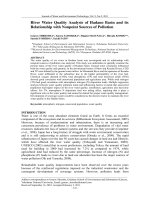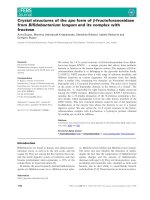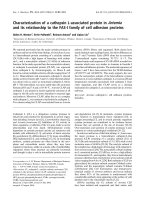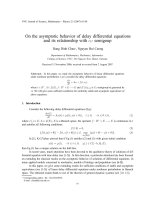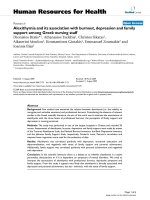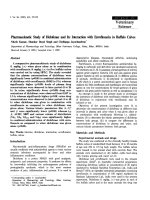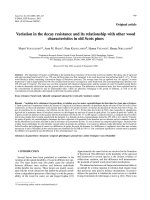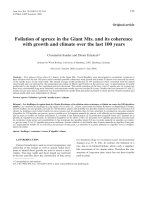Paternal Postpartum Depression And Its Relationship With Maternal Postpartum Depression.pdf
Bạn đang xem bản rút gọn của tài liệu. Xem và tải ngay bản đầy đủ của tài liệu tại đây (549.93 KB, 7 trang )
See discussions, stats, and author profiles for this publication at: />
Paternal Postpartum Depression and Its Relationship With Maternal
Postpartum Depression
Article in Journal of Holistic Nursing and Midwifery · March 2018
DOI: 10.29252/hnmj.28.2.115
CITATIONS
READS
10
625
5 authors, including:
Mahin Kamalifard
Jalil Babapour
Tabriz University of Medical Sciences
University of Tabriz
51 PUBLICATIONS 329 CITATIONS
58 PUBLICATIONS 375 CITATIONS
SEE PROFILE
SEE PROFILE
Some of the authors of this publication are also working on these related projects:
Health psychology View project
: Comparison of the effect of lavandula and citrus aurantium on depression and sleep quality in menopausal women: a randomized controlled trial View project
All content following this page was uploaded by Mahin Kamalifard on 16 April 2018.
The user has requested enhancement of the downloaded file.
March 2018, Volume 28, Number 2
[ DOI: 10.29252/hnmj.28.2.115 ]
Original Paper
Paternal Postpartum Depression and Its Relationship With
Maternal Postpartum Depression
Mahin Kamalifard1, Somayeh Bayati Payan1*, Samira Panahi1, Shirin Hasanpoor1, Jalil Babapour Kheiroddin2
1. Department of Midwifery, Instructor, Faculty of Nursery and Midwifery, Tabriz University of Medical Sciences, Tabriz, Iran.
2. Department of Psychology, Professor, Faculty of Psychology and Educational Sciences, Tabriz University of Medical Sciences, Tabriz, Iran.
Downloaded from hnmj.gums.ac.ir at 19:38 IRDT on Monday April 16th 2018
Use your device to scan
and read the article online
Citation: Kamalifard M, Bayati Payan S, Panahi S, Hasanpoor Sh, Babapour Kheiroddin J. Paternal Postpartum Depression and Its Relationship With Maternal Postpartum Depression. J Holist Nurs Midwifery. 2018; 28(2):115-120. https://doi.
org/10.29252/HNMJ.28.2.115
Running Title: Paternal Postpartum Depression and Its Relationship With MPD. J Holist Nurs Midwifery
:
: />
Article info:
Received: 02/04/2017
Accepted: 09/25/2017
ABSTRACT
Introduction: Evidence shows that some men suffer from Postpartum Depression (PPD), and
that the adverse effects of this unknown phenomenon affect them and their family.
Objective: The purpose of this study was to determine paternal PPD and its relationship with
some factors, especially maternal PPD.
Materials and Methods: This cross-sectional study was performed on 205 couples who were
selected using a random cluster sampling in seven health centers affiliated to the Shahid
Beheshti University of Medical Sciences six to 12 weeks after childbirth. Data was collected
from fathers using the Edinburgh Postnatal Depression Scale (EPDS) and a demographic
questionnaire. The Edinburgh questionnaire was also used for the mothers. Data analysis was
performed using descriptive statistics and the Pearson correlation as well as the Chi-square
and linear regression.
Results: A total of 11.7% of the fathers had depression symptoms. There was a significant and
direct correlation between the paternal and maternal PPD scores (r=0.29, P=0.001). Among
the sociodemographic and fertility factors, there was a significant relationship only between
a family’s livelihood situation, the number of abortions and the number of pregnancies with
the parental depression scores (P=0.05). In the regression analysis, maternal PPD (ß=0.22)
and the family’s livelihood situation (ß=0.44) predicted paternal depression (P=0.001). This
model totally explained about 30% of the changes in paternal PPD (R2=0.298).
Keywords:
Postpartum depression,
Mothers, Family, Risk factors
Conclusion: Considering the significant frequency of depression in fathers and the role of
maternal depression as well as the family’s livelihood situation, it is recommended that
evaluation should be carried out on paternal PPD and its risk factors in order to prevent and
treat it in a timely manner.
* Corresponding Author:
Somayeh Bayati Payan, MSc.
Address: Department of Midwifery, Faculty of Nursery and Midwifery, Tabriz University of Medical Sciences, Tabriz, Iran.
Tel: +98 (910) 9193208
E-mail:
115
[ DOI: 10.29252/hnmj.28.2.115 ]
March 2018, Volume 28, Number 2
T
Introduction
Downloaded from hnmj.gums.ac.ir at 19:38 IRDT on Monday April 16th 2018
he transition to parenthood is a stressful experience for parents [1], which creates many
challenges and concerns in the life of the couple [2, 3]. Maternal Postpartum Depression
(PPD) has been studied by many researchers,
but although men may also develop depression after
childbirth, this problem remains an unknown phenomenon [4, 5]. Since fathers today play a more active role in
the care of their infants compared to previous generations, it is essential and inevitable to take into account
their mental health as well [6, 7].
Depression symptoms in men are not as apparent as
in women and may be followed by isolation, anxiety and
restlessness, pessimism, hostility, violence, alcohol, as
well as illegal substance use and illicit relations instead
of grief [5, 7, 8]. Father’s PPD has a mysterious start and
a gradual progression [4]. The prevalence of PPD differs
in different societies and researches. It has been reported to be between 30% and 40% among Iranian mothers [9, 10]. PPD was relatively common in fathers [11].
The PPD rate in the first year postpartum ranged from
1.2 to 27.5 % in Ireland, Poland, and several other countries [6], with the figure being 8.2% in Canada, 12.5% in
China, and 5–10% in a review study [12-14].
Many studies showed that a father’s anxiety and depression were associated with increased risk of emotional-psychological disorders in the father and family
members, along with marital maladjustment, excessive
reproach, higher distress levels, and mood problems in
infants. Other reasons include anti-social behaviors in
children, hyperactivity, behavioral problems, especially
in boys, increased health costs [11, 14, 15], and the
probability of infanticide [1]. The results of the studies
examining the risk factors for father’s PPD are contradictory. Some reported factors include unwanted pregnancy, birth of daughter [16], marital incompatibility [12],
having other children, old age, pregnancy anxiety, low
education, spouse’s depression during pregnancy and
postpartum [4, 11], and maternal PPD [17]. The biological factors include changes in levels of testosterone,
estrogen, cortisol, vasopressin, and prolactin, while the
ecological factors include changes in lifestyle, marital relationships, difficulty in establishing attachment behaviors with the fetus, and lack of proper pattern for playing
the parental role [1].
According to the World Health Organization’s (WHO)
recommendation, depression can be diagnosed and
treated in primary health care centers, and midwives have
116
a good opportunity to diagnose father’s PPD because of
their proximity to families [5, 18]. There is inadequate
information on father’s PPD and its prevalence and risk
factors, and researchers believe that more research is required among families with different ethnic, cultural, and
economic backgrounds. This is to increase their level of
awareness in this area and develop diagnostic tools and
therapeutic programs [1, 4, 18]. Considering the prevalence of father’s PPD reported in some foreign studies, its
adverse effects, multi-factorial nature, and inaccessibility of basic information in the country, the present study
aimed at determining father’s depression and its related
factors. It aimed to find out, in particular, maternal PPD
among couples covered by health centers of the Shahid
Beheshti University of Medical Sciences in Tehran.
Materials and Methods
This is an analytical cross-sectional study that was
performed on all eligible couples who were referred to
health centers of the Shahid Beheshti University of Medical Sciences six to 12 weeks after the birth of their child.
The cluster sampling method was used. At first, about
10% of the health centers (a total of seven centers) were
randomly selected using the drawing method from a total
of 72 health centers covered by the Shahid Beheshti University of Tehran in all four urban areas (two from north,
two from east, two from west, and one from northwest
of Tehran, respectively). Then samples of each health
center were selected from eligible couples on a regular
basis from December 2012 to May 2013. To calculate the
sample size, a pilot study was carried out on 30 eligible
fathers in two health centers. Then, the sample size was
estimated to be 200 using the formula for estimating the
ratio and the p value of 0.07, obtained from the study
as well as by taking into account q=0.93, z=1.96, d=0.05,
and design effect=2. Finally, to increase the reliability of
the study and the probability of drop-outs, the sampling
continued until selection of up to 230 couples. After collecting the questionnaires and deleting the incomplete
submissions, a total of 205 couples were analyzed.
The inclusion criteria of the couples included: being
Iranian and a resident of Tehran with at least elementary education; six to 12 weeks after birth of the child;
couples should be living together; and a healthy newborn without any history of admission. Other criteria included no history of mental disease, depression,
or chronic diseases causing symptoms of depression,
non-use of drugs as well as drugs affecting the human
psyche, and no incidence of mood disorders in the last
six months. This was done according to the statements
by the participants. After meeting with couples and giv-
Kamalifard M, et al. Paternal Postpartum Depression and Its Relationship With MMD. J Holist Nurs Midwifery. 2018; 28(2):115-120.
Downloaded from hnmj.gums.ac.ir at 19:38 IRDT on Monday April 16th 2018
[ DOI: 10.29252/hnmj.28.2.115 ]
March 2018, Volume 28, Number 2
ing a full description of the research, its objectives and
the confidentiality of information, the researcher received their written consent, provided them with questionnaires, and requested them to answer questions
separately without interacting with each other. They
were to be submitted later. Sampling was performed on
weekdays during office hours.
The instrument used to collect data from the fathers
included the self-reporting EPDS and a researcher-made
questionnaire on sociodemographic factors and fertility. The Edinburgh Scale was only used for mothers.
This scale underwent psychometric assessment in Iran
[19] and consisted of 10 multiple-choice questions with
a score of 0–3 and the total score range varied from 0
to 30. This instrument has been validated in several regions, including Australia, Hong Kong, and Vietnam for
men [20-22]. However, in the case of fathers, its content
validity was verified by nine faculty members of the Tabriz University of Medical Sciences and its reliability was
investigated using internal consistency. Cronbach’s alpha
of 0.79 was obtained based on the pilot study. Also, Massoudi showed, in a study, that a score of 12≤ [3] was indicative of PPD for couples, which does not necessarily
mean a definitive clinical diagnosis of depression.
The researcher-made questionnaire on the father’s
demographic characteristics consisted of 21 questions
with 12 items being related to social-demographic characteristics and nine questions related to fertility characteristics. At the end of the study, data analysis was
performed using descriptive statistics (mean, standard
deviation, and frequency-percent) and inferential statistics (Pearson correlation coefficient, Chi-square, and
linear regression) in SPSS software V. 17. This study was
carried out after obtaining permission from the ViceChancellor of Research and Technology of the Tabriz
University of Medical Sciences and the Vice-Chancellor
for Health of the Shahid Beheshti University of Medical Sciences in Tehran. This research was approved with
ethical code 91129.
Results
The findings of the present research showed that the
mean age of fathers and their wives was 32.63±0.5 and
28.24±4.47 years, respectively. The majority of fathers
(39.5%) had university education. Most of them were
Farsi speakers (44.9%) and self-employed (43.4%). A total of 55.1% of them were first-time fathers and there
was no history of an abortion in 86.8% of the cases. A
total of 84.9%, 71.9%, and 87.3% of pregnancies were
wanted, uncomplicated, and full-term, respectively.
Most of the babies (53.2%) were boys and 88.3% of the
parents were satisfied with the gender of their infants.
A total of 42% of them were tenants and 52.9% had
economic status in moderate level. Also, 58.2% of fathers mentioned their wives as the first source of social
support. The overall mean of depression in the fathers
was 5.96±4.43. Twenty-four of the fathers scored 12 or
higher on the Edinburgh scale, indicating the presence
of symptoms of depression. Also, the percentage of maternal PPD was determined in 33.2% of the cases. The
results of the Pearson correlation test showed a direct
and significant statistical relationship among the PPD
scores of the parents (P=0.001, r=0.29). As a result, the
paternal depression score increased in proportion to
the increase in the maternal depression score.
The chi-square test showed a significant statistical relationship between the family livelihood situation and
PPD while determining the relationship between the
sociodemographic factors and paternal PPD (Table 1)
(P=0.001, df=3 x2=29.8). Half of the fathers who were
barely making ends meet were depressed, and there
was no depression in any of the fathers who had high
economic status. There was no significant relationship
between other sociodemographic variables and paternal depression. Among the fertility factors (Table 2),
the Pearson correlation test showed a direct and significant relationship between the number of abortions
(r=0.152, P=0.03) and the number of wife’s pregnancies
(r=0.151, P=0.031) with parental PPD. There was no significant relationship between other fertility factors and
paternal PPD. The multiple linear regression analysis
was then conducted to determine the contribution of
each of the variables associated with paternal depression in explaining its changes (Table 3). Independent
variables, based on the determination coefficient (R2),
significantly explained about 30% of changes in the
overall paternal PPD (P=0.001). Of this, only the maternal PPD and family livelihood situation variables could
predict significant paternal depression.
Discussion
The present research showed a direct correlation between the paternal and maternal depression scores.
The latter was considered one of the predictors of parental PPD. Paulson and Bazemore also reported in their
studies a positive and moderate correlation between
parental and maternal depression [23]. In cases where
a woman suffers from PPD, fathers are expected to be
more involved in family affairs than before. In the event
of prolonged maternal depression, a man’s mental adaptation becomes disrupted due to lack of adequate
Kamalifard M, et al. Paternal Postpartum Depression and Its Relationship With MMD. J Holist Nurs Midwifery. 2018; 28(2):115-120.
117
[ DOI: 10.29252/hnmj.28.2.115 ]
March 2018, Volume 28, Number 2
Downloaded from hnmj.gums.ac.ir at 19:38 IRDT on Monday April 16th 2018
Table 1. Relationship of sociodemographic factors with parental postpartum depression
Sociodemographic Characteristics
Results
Sig.
Father’s age
r=0.112
0.111*
Mother’s age
R=0.014
0.840*
Time elapsed since marriage
r=0.048
0.509*
Father’s education
df=4
0.295**
Mother’s education
df=4
0.325**
Father’s ethnicity
df=5
0.569**
Mother ethnicity
df=5
0.541**
Father’s job
df=4
0.060**
Mother’s job
df=4
0.271**
Livelihood situation
df=3
0.000**
Type of housing
df=3
0.642**
The first source of social support for the father
df=4
0.891**
* Pearson test
** Chi-square test
Table 2. Relationship between fertility factors and the parental postpartum depression
Fertility Characteristics
Results
Sig.
Number of pregnancies
r=0.151
0.031*
Number of abortions
r=0.152
0.030*
Number of deliveries
r=0.084
0.233*
Number of children
r=0.080
0.258*
Unwanted pregnancy
df=3
0.053**
Infant gender
df=1
0.590**
Satisfaction with the baby gender
df=1
0.421**
Preterm labor
df=1
0.977∗∗
Complicated pregnancy
df=5
0.397∗∗
* Pearson Test
** Chi-square test
Table 3. Summary of regression model of parental postpartum depression
118
Predictor Variables
B
SE
Beta
T
Sig.
Maternal postpartum depression
0.201
0.054
0.221
3.695
0.000
Number of abortions
1.076
0.787
0.100
1.368
0.173
Number of pregnancies
0.611
0.429
0.104
1.425
0.156
Livelihood situation
2.657
0.368
0.440
7.334
0.000
Kamalifard M, et al. Paternal Postpartum Depression and Its Relationship With MMD. J Holist Nurs Midwifery. 2018; 28(2):115-120.
Downloaded from hnmj.gums.ac.ir at 19:38 IRDT on Monday April 16th 2018
[ DOI: 10.29252/hnmj.28.2.115 ]
March 2018, Volume 28, Number 2
support; his stress increases and predisposes him to
depression [4, 16, 17]. However, Nishimura and Ohashi
reported no correlation between couples depressed in
Japan. They attributed it to the existence of supportive
traditions in their country, according to which a father
lives away for a while from his wife after childbirth [17].
In this research, among the sociodemographic factors,
a significant relationship was observed only between
the family livelihood situation and father’s PPD. Another
study showed that there was a relationship between the
economic situation and a father’s Edinburgh scores, but
it did not predict the paternal PPD [24]. In many societies, it is the man’s duty to guarantee the family’s financial security. After the birth of the child, due to the
increased financial burden on the family, more emphasis
was placed on the breadwinning role of the man, and
the father had less opportunity to perform parental duties. In the face of functional weaknesses in the professional and gender roles, the risk of psychiatric distresses
increases [7, 25].
The results also showed that there was no significant
relationship between the father’s PPD and other sociodemographic factors. de Montigny’s research also
showed no relationship between the father’s PPD and
demographic factors, including age, education, and
marriage duration [12]. Among fertility factors, the
number of abortions was significantly correlated with
the father’s PPD. De Montigny also showed that paternal PPD was associated with a history of abortion,
which could not predict PPD, as in this study [12]. Mothers who have had a history of abortion have a greater
sense of failure, disappointment, and incompetence
[26, 27], and since the mental situation of couples has
an effect on both of them, the father may experience
these feelings. In the present study, there was no relationship between the number of children and the delivery with PPD, which was consistent with Lashkaripour’s
study conducted on mothers [28].
In contrast to Gao’s [16] study, the father’s depression
was not significantly related to unwanted pregnancy
in the present research. Also, there was no significant
relationship between a father’s PPD and preterm labor, which was consistent with the result of Nishimura
and Ohashi’s study [17]. In general, a complex combination of various variables is involved for depression
to occur. This is likely affected by the existing cultural
and social differences of people in different societies.
The contradictory findings of previous studies show the
need for further studies in various statistical societies.
The non-generalizability of the results of the present
study in the context of other cities and villages in Iran
along with its cross-sectional design were among some
of the limitations of the research. Therefore, further
longitudinal and cohort studies are recommended in
various cultural and social environments. Also, there is
a need to investigate other PPD-related factors. In the
present research, a significant number of fathers had
symptoms of PPD. Considering the clinical significance of
this phenomenon and its relationship with the mother’s
PPD and some other factors, it is recommended that in
addition to raising public awareness and implementing
educational programs on childbirth, fathers must also
be investigated for mood disorders and predisposing
factors during this period, especially when their wives
are depressed.
Acknowledgments
This article is the result of a master’s thesis wich the
authors would like to appreciate the Vice-Chancellor of
the Research and Student Research Committee of Tabriz
University of Medical Sciences for funding the research,
officials of the Nursing and Midwifery Faculty of Tabriz,
Deputy of Health of the University of Medical Sciences
Shahid Beheshti, all the staff of the health centers and
dear ones who helped us in this regard.
Conflict of Interest
The authors declared no conflicts of interest. All authors have agreed on the final version and meet at least
one of the ICMJE authorship criteria, including substantial contributions to conception and design, acquisition
of data, or analysis and interpretation of data, drafting
the article or revising it critically for important intellectual content.
References
[1] Kim P, Swain J. Sad dads: Paternal postpartum depression. Psychiatry (Edgmont). 2007; 4(2):35-47. PMID: 20805898
[2] John WS, Cameron C, McVeigh C. Meeting the challenge of
new fatherhood during the early weeks. Journal of Obstetric, Gynecologic & Neonatal Nursing. 2005; 34(2):180-9. doi:
10.1177/0884217505274699
[3] Massoudi P. Depression and distress in Swedish fathers in the
postnatal period– prevalence, correlates, identificaton, and support
[PhD thesis]. Gothenburg: University of Gothenburg; 2013.
[4] Goodman JH. Paternal postpartum depression, its relationship
to maternal postpartum depression, and implications for family health. Journal of Advanced Nursing. 2004; 45(1):26-35. doi:
10.1046/j.1365-2648.2003.02857.x
Kamalifard M, et al. Paternal Postpartum Depression and Its Relationship With MMD. J Holist Nurs Midwifery. 2018; 28(2):115-120.
119
[ DOI: 10.29252/hnmj.28.2.115 ]
March 2018, Volume 28, Number 2
[5] Melrose S. Paternal postpartum depression: How can nurses begin
to help? Contemporary Nurse. 2010; 34(2):199-210. doi: 10.5172/
conu.2010.34.2.199
[6] Wilson CC. Paternal postpartum distress: A discourse analytic
study [PhD Thesis]. Hull: University of Hul; 2008.
[7] Veskrna L. Peripartum depression –does it occur in fathers and
does it matter? Journal of Men's Health. 2010; 7(4):420–30. doi:
10.1016/j.jomh.2010.10.004
[8] Spector AZ. Fatherhood and depression: A review of risks, effects,
and clinical application. Issues in Mental Health Nursing. 2006;
27(8):867-83. doi: 10.1080/01612840600840844
[9] Hosseini H, Naghibi AH, Khademloo M. [Post partum depression
Downloaded from hnmj.gums.ac.ir at 19:38 IRDT on Monday April 16th 2018
and its relationship with some related factors (Persian)]. Journal of
Babol University of Medical Sciences. 2008; 10(2):76-81.
[10] Rubintan N, Esmaeelpur K, Mahmudalilu M, Seyedrasuli E. [The
relationship of type of delivery and infant feeding with postpartum
depression (Persian)]. Medical Journal of Tabriz University of Medical Science & Health Service. 2012; 34(3):52-6.
[11] Ramchandani PG, Stein A, Oconnor T, Heron J, Murray L, Evans
J. Depression in men in the postnatal period and later child psychopathology: a population cohort study. Journal of the American
Academy of Child & Adolescent Psychiatry. 2008; 47(4): 390-8. doi:
10.1097/chi.0b013e31816429c2
[12] de Montigny F, Girard ME, Lacharité C, Dubeau D, Devault A.
Psychosocial factors associated with paternal postnatal depression.
Journal of Affective Disorders. 2013; 150(1):44–9. doi: 10.1016/j.
jad.2013.01.048
[13] Mao Q, Zhu LX, Su XY. A comparison of postnatal depression and
related factors between Chinese new mothers and fathers. Journal
of Clinical Nursing. 2011; 20(5-6):645–52. doi: 10.1111/j.13652702.2010.03542.x
[14] Ramchandani P, Psychogiou L, Vlachos H, Iles J, Sethna V, Netsi
E, et al. Paternal depression: an examination of its links with father,
child and family functioning in the postnatal period. Depression and
Anxiety. 2011; 28(6):471-7. doi: 10.1002/da.20814
Psychiatry Research. 2010; 180(2-3):80-5. doi: 10.1016/j.psychres.2009.07.015
[21] Matthey S, Barnett B, Kavanagh DJ, Howie P. Validation of the
Edinburgh Postnatal Depression Scale for men, and comparison of
item endorsement with their partners. Journal of Affective Disorders. 2001; 64(2-3):175-84. doi: 10.1016/s0165-0327(00)00236-6
[22] Tran TD, Tran T, Fisher J. Validation of three psychometric instru-
ments for screening for perinatal common mental disorders in men
in the north of Vietnam. Journal of Affective Disorders. 2012; 136(12):104-9. doi: 10.1016/j.jad.2011.08.012
[23] Paulson J, Bazemore S. Prenatal and postpartum depression in
fathers and its association with maternal depression. JAMA. 2010;
303(19):1961-9. doi: 10.1001/jama.2010.605
[24] Bielawska-Batorowicz E, Kassakowska-Petrycka K. Depressive
mood in men after the birth of their offspring in relation to a partner’s depression, social support, father’s personality and prenatal
expectations. Journal of Reproductive and Infant Psychology. 2006;
24(1):21-9. doi: 10.1080/02646830500475179
[25] Anderson EA, Kohler JK, Letiecq BL. Predictors of depression
among low-Income, nonresidential fathers. Journal of Family Issues.
2005; 26(5):547-67. doi: 10.1177/0192513x04272753
[26] Kiani F, Khadivzade T, Sargolzaei M, Behnam H. [Relationship
between marital satisfaction during pregnancy and postpartum depression (Persian)]. Iranian Journal of Obstetrics, Gynecology and
Infertility. 2009; 13(5):37-44.
[27] Astaraki L. [Survey of parental – fetal attachment and associated
factors in pregnant women of health and medical centers and their
husbands, affiliated to Tehran universities of medical science in Tehran (Persian)] [MSc. Thesis]. Tehran: Tehran University of Medical
Sciences; 2011
[28] Lashkaripour K, Bakhshani NM, Hokmabadi S, Sajjadi SAR, Sarasi-
yabi AS. [Postpartum depression and related factors: A 4.5 months
study (Persian)]. Journal of Fundamentals of Mental Health. 2012;
13(4):404-12.
[15] Ramchandani P, Stein A, Evans J, O’Connor T. Paternal depres-
sion in the postnatal period and child development: a prospective
population study. Lancet. 2005; 365(9478):2201-5. doi: 10.1016/
s0140-6736(05)66778-5
[16] Gao L, Chan S, Mao Q. Depression, perceived stress,and social
support among first-time Chinese mothers and fathers in the postpartum period. Research in Nursing & Health. 2009; 32(1):50–8.
doi: 10.1002/nur.20306
[17] Nishimura A, Ohashi K. Risk factors of paternal depression in the
early postnatal period in Japan. Nursing & Health Sciences. 2010;
12(2):170-6. doi: 10.1111/j.1442-2018.2010.00513.x
[18] Schumacher M, Zubaran C, White G. Bringing birth-related pa-
ternal depression to the fore. Women and Birth. 2008; 21(2):65-70.
doi: 10.1016/j.wombi.2008.03.008
[19] Ahmadi Kani Golzar A, GoliZadeh Z. [Validation of Edinburgh
Postpartum Depression Scale (EPDS) for screening postpartum
depression in Iran (Persian)]. Iranian Journal of Psychiatric Nursing.
2015; 3(3):1-10.
[20] Lai BP, Tang AK, Lee DT, Yip AS, Chung TK. Detecting postnatal
depression in Chinese men: A comparison of three instruments.
120
Kamalifard M, et al. Paternal Postpartum Depression and Its Relationship With MMD. J Holist Nurs Midwifery. 2018; 28(2):115-120.
